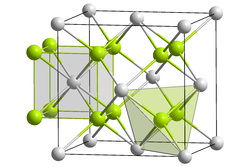 | |
| Identifiers | |
|---|---|
3D model (JSmol) | |
CompTox Dashboard (EPA) | |
| |
| |
| Properties | |
| RaF2 | |
| Molar mass | 263.8214 g/mol [1] |
| Appearance | White cubic crystals [1] |
| Density | 6.7 g/cm3 [1] |
| Hazards | |
| Occupational safety and health (OHS/OSH): | |
Main hazards | Highly radioactive and toxic |
| GHS labelling: | |
 | |
| H350 | |
Except where otherwise noted, data are given for materials in their standard state (at 25 °C [77 °F], 100 kPa). | |
Radium fluoride is an inorganic compound with a chemical formula of RaF2. This salt, like all radium compounds, is highly radioactive. It can be coprecipitated with lanthanide fluorides. [2] Radium fluoride has the same crystal form as calcium fluoride (fluorite).[ citation needed ] However, calculations suggest that radium fluoride vapor consists of RaF2 molecules, with a bond angle of 118°, due to substantial covalent interaction within the molecule. [3]